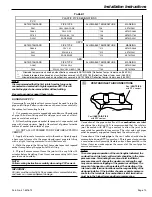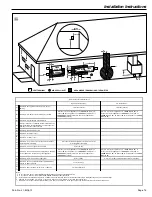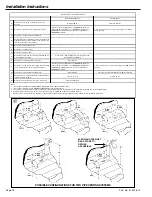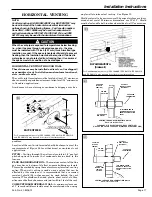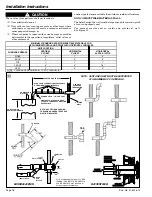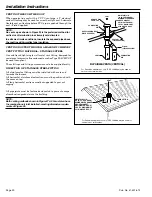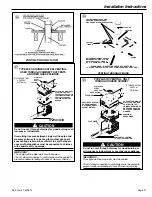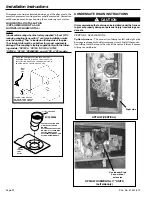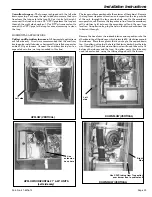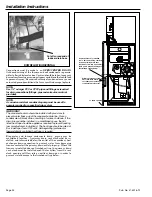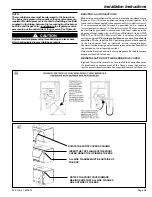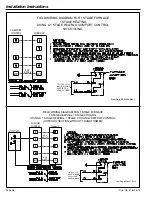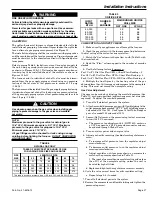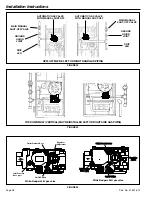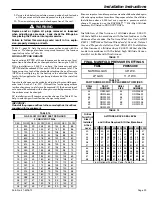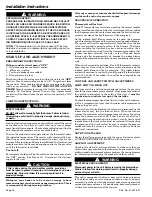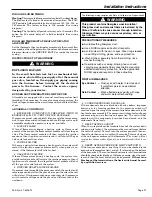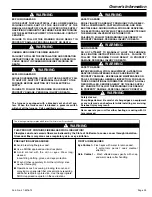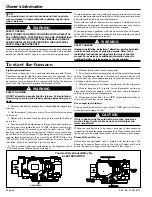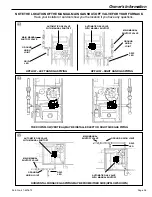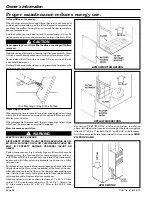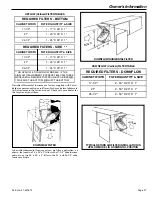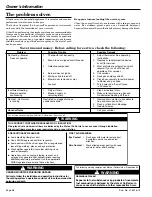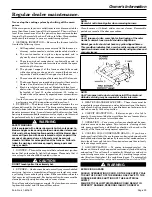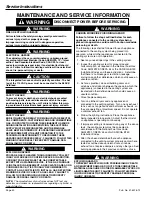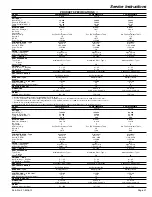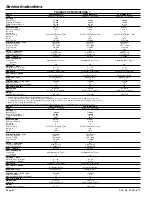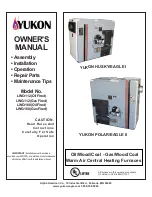
Installation Instructions
Page 27
Pub. No. 41-5016-12
▲
WARNING
!
FIRE OR EXPLOSION HAZARD
Failure to follow the safety warnings exactly could result in
serious injury, death or property damage.
Never test for gas leaks with an open flame. Use a commer-
cially available soap solution made specifically for the detec-
tion of leaks to check all connections. A fire or explosion may
result causing property damage, personal injury, or loss of life.
GAS PIPING
The upflow/horizontal furnace is shipped standard for left side
installation of gas piping. A knockout is provided on the right side
for an alternate gas piping arrangement. See Figure 32.
The installation of piping shall be in accordance with piping codes
and the regulations of the local gas company. Pipe joint compound
must be resistant to the chemical reaction with liquefied petro-
leum gases.
Refer to piping Table 8, for delivery sizes. Connect gas supply to
the unit, using a ground joint union and a manual shut-off valve
as shown in Figures 32 & 33. National codes require a condensa-
tion drip leg to be installed ahead of the controls as shown in
Figures 32 & 33.
The furnace and its individual shut-off valve must be discon-
nected from the gas supply piping system during any pressure
testing of that system at test pressures in excess of 1/2 psig
(3.5 kPa).
The furnace must be isolated from the gas supply piping by closing
its individual manual shut-off valve during any pressure testing
of the gas supply piping system at test pressures equal to or less
than 1/2 psig (3.5 kPa).
▲
CAUTION
!
Use a backup wrench on the gas valve when installing gas
piping to prevent damage to the gas valve and manifold
assembly.
NOTE:
Maximum pressure to the gas valve for natural gas is
13.8" W.C. Minimum pressure is 5.0" W.C. Maximum
pressure to the gas valve for propane is 13.8" W.C.
Minimum pressure is 11.0" W.C.
All gas fittings must be checked for leaks using a soapy
solution before lighting the furnace. DO NOT CHECK WITH
AN OPEN FLAME!
COMBUSTION AND INPUT CHECK
1. Make sure all gas appliances are off except the furnace.
2. Clock the gas meter with the furnace operating (determine
the dial rating of the meter) for one revolution.
3. Match the “Sec” column in the gas flow (in cfh) Table 10 with
the time clocked.
4. Read the “Flow” column opposite the number of seconds
clocked.
5. Use the following factors if necessary:
For 1 Cu. Ft. Dial Gas Flow CFH = Chart Flow Reading ÷ 2
For 1/2 Cu Ft. Dial Gas Flow CFH = Chart Flow Reading ÷ 4
For 5 Cu. Ft. Dial Gas Flow CFH = 10X Chart Flow Reading ÷ 4
6. Multiply the final figure by the heating value of the gas
obtained from the utility company and compare to the nameplate
rating. This must not exceed the nameplate rating.
Gas Valve Adjustment
Changes can be made by adjusting the manifold pressure (See
Table 11), or changing orifices (orifice change may not always be
required). To adjust the manifold pressure:
1. Turn off all electrical power to the system.
2. Attach a manifold pressure gauge with flexible tubing to the
outlet pressure boss marked “OUT P” on White-Rodgers gas
valve model 36G or 36J. See Figure 34 for White-Rodgers
gas valve model 36J and model 36G.
3. Loosen (Do Not remove) the pressure tap test set screw one
turn with 3/32" hex wrench.
a. The pressure tap adjustment kit (KIT07611) contains
a 3/32" hex wrence, a 5/16" hose and a connector and can
be ordered through Global Parts.
4. Turn on system power and energize valve.
5. Adjust gas heat by removing the adjustment regulator cover
screw.
a. To increase outlet pressure, turn the regulator adjust
screw clockwise.
b. To decrease outlet pressure, turn the regulator adjust
screw counterclockwise.
c. Adjust regulator until pressure shown on manometer
matches the pressure specified in Table 11.
1. The input of no more than nameplate rating and no less
than 93% of the nameplate rating, unless the unit is
derated for high altitude.
d. Replace and tighten the regulator cover screw securely.
6. Cycle the valve several times to verify regulator setting.
a. Repeat steps 5-6 if needed.
7. Turn off all electrical power to the system.
8. Remove the manometer and flexible tubing and tighten the
pressure tap screw.
TABLE 9
ORIFICE SIZES
INPUT
RATING
BTUH
NUMBER
OF
BURNERS
MAIN BURNER ORIFICE
DRILL SIZE
NAT. GAS
LP GAS
40,000
60,000
80,000
100,000
120,000
2
3
4
5
6
45
45
45
45
45
56
56
56
56
56
TABLE 8
NATURAL GAS ONLY
TABLE OF CUBIC FEET PER HOUR OF GAS
FOR VARIOUS PIPE SIZES AND LENGTHS
PIPE
SIZE
LENGTH OF PIPE
10
20
30
40
50
60
70
1/2
132
92
73
63
56
50
46
3/4
278
190
152
130
115
105
96
1
520
350
285
245
215
195
180
1-1/4
1050
730
590
520
440
400
370
This table is based on pressure drop of 0.3 inch W.C. and 0.6 SP.GR. gas

